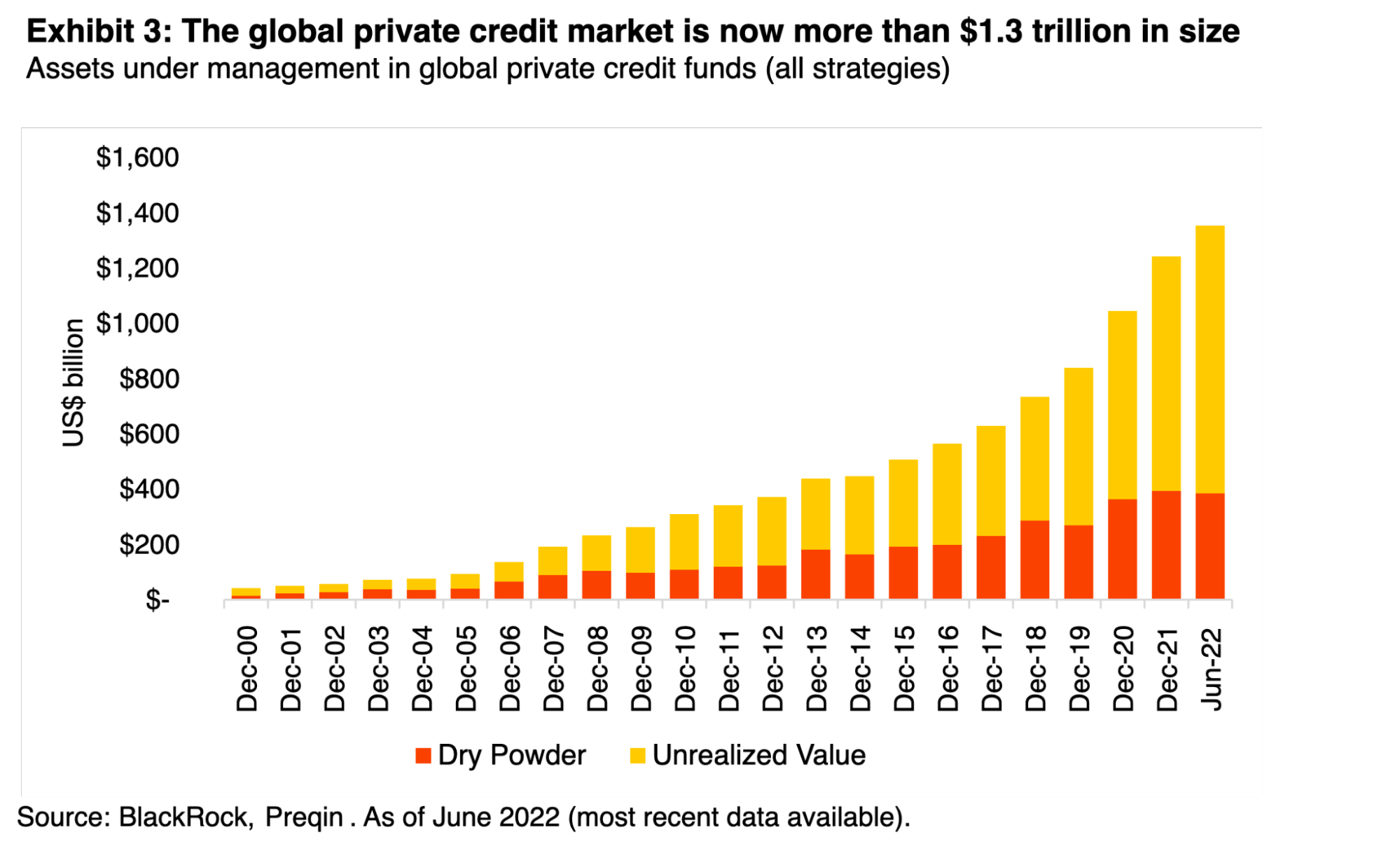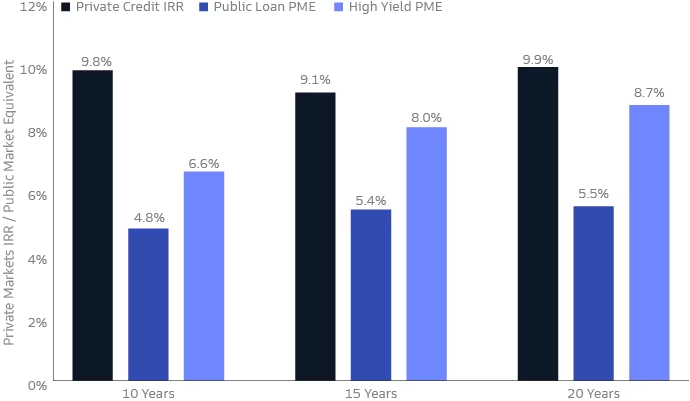What Is Private Credit? Pros, Cons, and How to Invest

The private credit market has exploded in popularity during the last few years for one reason: risk-adjusted returns.
Unlike many other "alternative" asset classes, private credit has a track record of actually delivering those returns.
And while private credit used to be exclusively available to pensions, hedge funds, and private equity, that's no longer the case — individual investors can also now get in on this asset class.
Here's everything you need to know about private credit and how to invest in it.
What is private credit?
Private credit is a loan to a business by any non-bank lender.
Borrowers are typically mid-sized companies that need financing for operations, an acquisition, or to improve their balance sheet. The vast majority of these borrowers are private companies and do not have access to public debt markets.
Following the 2008–2009 financial crisis, a series of banking regulations were put in place to prohibit banks from making certain types of loans.
Because of this, many private companies do not have access to traditional bank financing. That's where private credit comes in.
Private credit lenders do not have the same restrictions and can evaluate deals independently of any regulatory body.
Additionally, even if a borrower has access to bank financing, they may choose to work with private credit lenders anyway because of their flexible terms, customizable loan structures, and faster processing times.
Where to invest
Our favorite platforms for investing in private credit are Percent and Yieldstreet.
The market for private credit
As mentioned above, private credit borrowers are mid-sized companies that typically generate between $10 million and $150 million in annual EBITDA.
While that seems like a lot of money (and it is), it pales in comparison to publicly traded companies. For example, the 497th largest company in the U.S. — Northern Trust Corporation (NTRS) — generated $1.5 billion in EBITDA last year.
In lending terms, this segment is known as the “middle market.” Most of these companies have proven business models, have been around for years, and have established market positions.
Regulatory reforms left this segment under-financed, which opened the door to private credit providers. And, because of the attractive terms (more on that below), money has flooded in:

Source: BlackRock
More recent data from Preqin shows the private credit market had grown to $1.6 trillion as of March 2023, up from $500 billion at the end of 2015. Preqin estimates the market will reach $2.3 trillion by 2027.
Why invest in private credit?
To access funding, private credit borrowers must offer lenders more favorable terms than those lenders could receive in public markets.
Each loan has a custom structure, but most of them come with four primary benefits that make them attractive complements to traditional fixed-income investments:
- Higher yields
- Historically low default rates
- Short term durations
- Not correlated with the public markets
Below is more about each of these, including some data from Percent, the leading private credit platform for individual investors.
1. Higher yields
The most obvious thing for private credit borrowers to offer lenders to attract capital is a higher yield. But how much higher?
On Percent, the historical weighted average APY (annual return) has been 13.21% on matured deals since its inception in 2018. As of the time of this writing, the weighted average APY is over 18%.
For perspective, junk bonds (high-yield bonds that have a credit rating of BBB or lower) are currently paying 7.66%, according to YCharts.
2. Historically low default rates
I know what you're thinking, “Yes, but what are the default rates? They must be sky-high.” You'd be surprised.
Since 2018, Percent has had a 1.35% loss rate (total amount of money lost due to defaults). Just 1.72% of loans defaulted in 2023, lower than the 2–3% of high-yield bonds that defaulted last year, according to estimates by Reuters.
These favorable risk-adjusted returns (higher yields at lower default rates) are the main draw for private credit investors.
3. Short term durations
In 2023, the average term length for an investment on Percent was nine months.
Short-term durations allow for greater portfolio flexibility, enhanced liquidity, lower interest rate risk, and lower default risk.
Interest rate risk
Interest rate risk refers to the process of longer-term bonds losing value in a rising interest rate environment. Newly issued bonds will have higher yields than older bonds, which drives the prices of the older bonds lower. The shorter the maturity date on the bonds you hold, the less exposure you have to this risk.
While private credit investing does require more maintenance than buying 10-year Treasury bonds, most income-seeking investors appreciate this added layer of flexibility.
4. Uncorrelated with public markets
Like other alternative investments, private credit allows investors to diversify their portfolios outside of traditional public markets (stocks and bonds).
While stocks and bonds are supposed to move in opposite directions, they have become more and more correlated over the years and often move in lockstep with one another. When stocks have been down, bonds have been down, too.
Private credit investments, on the other hand, are not actively traded on any secondary exchange, so therefore investors are not subjected to the daily volatility seen in publicly traded fixed-income markets.
This can have the effect of increased stability in statement values for investors.
Overall performance of private credit
The above characteristics of private credit led to this market outperforming both the public credit market as a whole and the high-yield market on its own, as of December 2021:

Source: Goldman Sachs Asset Management
Drawbacks to investing in private credit
While there are obvious benefits to investing in private credit, this asset class does come with its own set of drawbacks.
- Illiquidity: It's often difficult or even impossible to sell private credit investments on the secondary market. When you invest in a deal, you should expect your cash to be locked up for the duration of the loan.
- Limited transparency: Unlike public markets, there isn't much public information about the companies you're lending money to, so you're much more reliant on the due diligence process of the platform you're investing through.
- Complex structures: Each deal has its own set of terms and conditions. These may include covenants, securities arrangements, and other contractual provisions. You will either need to sort through these details for each deal on your own or trust that your investing platform is providing good investments.
- Concentration risk: Private credit offerings are usually sold to only a few investors in relatively large sums. Depending on the minimum investment and the size of your portfolio, this may subject you to being overly concentrated in one investment. That said, many of Percent's deals have minimum investment amounts of just $500.
If you're considering investing in private credit, you should be aware of and comfortable with these risks. While its historical performance has been great, private credit is still considered a new and somewhat speculative asset class.
How to invest in private credit
Assuming you've weighed the pros and cons and decided to add private credit to your portfolio, here are the steps you should take:
- Define your allocation amount: You first need to determine how much of your portfolio to allocate to private credit. Research by KKR suggests high net worth households should invest up to 30% in alternative assets, with 10% going to private credit, although this is likely to be on the high end for most investors.
- Register with an investment platform: You'll need to sign up for an investment platform that allows individual investors to invest in private credit. Two of the most popular choices are Percent and Yieldstreet, which I compare below.
- Research investments: After choosing a platform, you'll need to decide which investments to make based on their available listings and your financial goals.
- Make a purchase: Invest in your first private credit deal.
There is more nuance to the process, but this gives you an overview of the most important steps.
Accredited investor status
To invest in private credit, you must be an accredited investor.
Accreditation requirements
You can qualify as an accredited investor if:
- You have an annual income of $200,000 individually or $300,000 jointly.
- Your net worth exceeds $1,000,000, excluding your primary residence.
- You are a qualifying financial professional.
If you qualify as an accredited investor, you can register for either Percent or Yieldstreet and start investing in private credit.
Yieldstreet's Alternative Income Fund
If you're not an accredited investor but are interested in investing in alternatives, check out Yieldstreet's Alternative Income Fund. The fund invests in multiple alternative asset classes, including private credit.
Platforms: Percent vs Yieldstreet
Our two favorite platforms for investing in private credit are Percent and Yieldstreet. Both are excellent options, though there are pros and cons to each.
| Percent | Yieldstreet | |
| Focus | Private credit | 11 alternative assets (private credit, private equity, art, real estate, and more) |
| Total invested on the platform | $952 million | $3.9 billion |
| Minimum investment | $500 | $10,000 |
| Primary benefit | Best selection of private credit deals | More alternative asset classes than any other platform |
Frequently asked questions
Below are a few more questions you may have about private credit.
Public credit vs private credit: what's the difference?
The main difference between the public and private credit markets is who the borrowers are.
- Public credit: In the public credit market, the borrowers are government entities (local, state, and federal) and publicly traded companies.
- Private credit: The private credit market serves non-public entities (everybody else).
There are several other secondary differences.
The public market is easier to access, has more liquidity, has a higher degree of transparency, is more heavily regulated, has more investors, and is much larger than the private market.
What is a private credit fund?
A private credit fund is an investment that pools money from multiple investors and invests in private credit deals. These funds are managed by professional investors who source, analyze, and manage all of the investments on behalf of their investors.
Different funds will have different investment objectives. If you're considering investing in one, be sure it matches the risk/reward profile you're looking for before investing your capital.
Are private debt and private credit the same?
Yes, private debt and private credit are the same.


.png)



